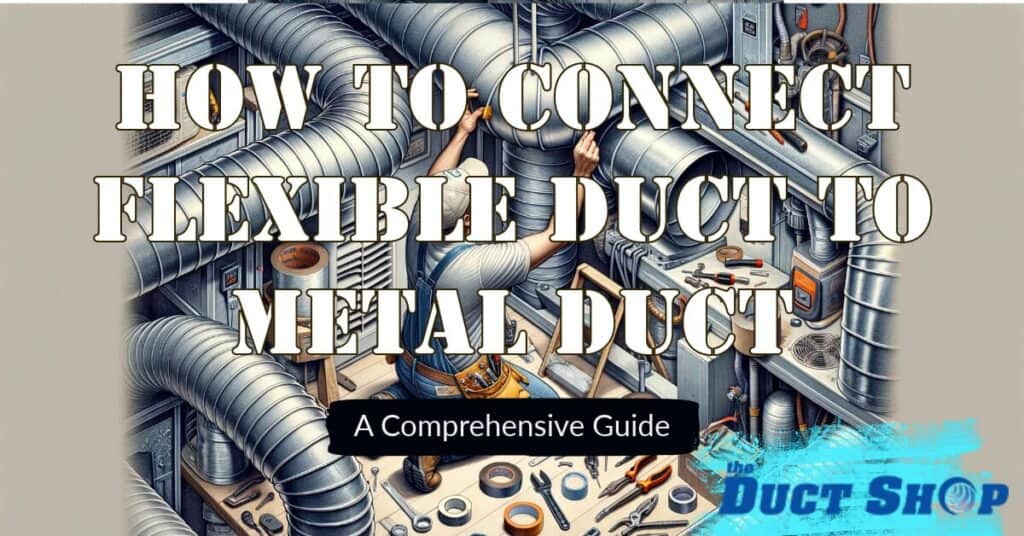Introduction
In the diverse and intricate world of HVAC (Heating, Ventilation, and Air Conditioning) systems, one of the key components for ensuring efficient operation is the proper installation and connection of ductwork. Ducts, the pathways through which warm or cool air travels throughout a building, come in various types and materials. Among these, the connection of flexible ducts to metal ducts is a common yet critical task. This process, while seemingly straightforward, involves a blend of precision, understanding of materials, and adherence to best practices to ensure a seamless and efficient air flow.
The need for connecting flexible ducts to metal ducts arises in various scenarios. Whether it’s during the installation of a new HVAC system, the extension of an existing system to new areas, or during repairs and upgrades, this task stands as a fundamental skill for both professionals and DIY enthusiasts. The flexible duct, known for its ease of installation and adaptability, is often used in tight spaces where rigid metal ducts are impractical. Conversely, metal ducts are known for their durability and are commonly used in main supply and return lines. The intersection of these two types of ducts is where attention to detail and proper technique become paramount.
This process, however, can be fraught with challenges if not approached correctly. An improper connection can lead to air leakage, reduced system efficiency, and even long-term damage to the HVAC system. Therefore, understanding the right tools, materials, and methods for connecting these different types of ductwork is essential. This not only ensures that the HVAC system operates at its optimum efficiency but also contributes to the overall air quality and energy efficiency of the building.
In this comprehensive guide, we will delve into the step-by-step process of connecting flexible ducts to metal ducts. We will cover everything from the tools and materials needed, to detailed instructions for each step of the process. Additionally, we will provide tips and best practices to ensure a secure and effective connection. Whether you’re a seasoned HVAC technician or a homeowner looking to tackle some DIY home improvement, this guide aims to equip you with the knowledge and confidence to successfully complete this task.
By the end of this article, you will have a thorough understanding of how to effectively connect flexible ductwork to metal ductwork, ensuring a robust and efficient HVAC system. Let’s dive in and explore the nuances of this essential HVAC task.
Tools and Materials Needed
To start, gather all necessary tools and materials. You’ll need:
- Flexible duct
- Metal duct
- Duct tape
- UL-181 rated foil tape
- Duct straps or heavy-duty plastic zip ties
- Sheet metal screws
- Screwdriver or drill
- Utility knife
- Gloves and safety glasses
- Duct mastic (optional but recommended)
Detailed Steps to Connect Flexible Duct to Metal Duct
Step 1: Preparation
First, ensure that the flexible duct is the appropriate size for the metal duct. Incorrect sizing can lead to inefficient airflow and potential system damage. Measure both ducts to confirm compatibility. Cut the flexible duct to the required length using a utility knife, making sure the cut is clean and even.
Step 2: Attach the Flexible Duct
Carefully extend the flexible duct over the end of the metal duct. The connection should be snug but not overly tight. If resistance is felt, gently stretch the end of the flexible duct. If the connection is too loose, consider using a duct reducer or connector for a better fit.
Step 3: Secure with Foil Tape
Once the flexible duct is in place, wrap UL-181 rated foil tape around the connection. This type of tape is designed for ductwork and provides a strong, long-lasting hold. It’s important to avoid using regular duct tape, as it is not durable enough for HVAC applications.
Step 4: Additional Security Measures
For extra security, use duct straps or heavy-duty plastic zip ties. Place these over the area where you applied the foil tape. This added step ensures the ducts remain connected even under varying air pressure conditions.
Step 5: Fasten with Screws
To reinforce the connection, fasten the flexible duct to the metal duct using sheet metal screws. Distribute the screws evenly around the circumference of the ducts. This mechanical fastening method provides additional strength to the connection.
Step 6: Apply Duct Mastic (Optional)
For an even more robust seal, consider applying duct mastic over the taped area. Duct mastic is a sealant that creates a durable, airtight bond, further enhancing the efficiency of your HVAC system.
Step 7: Final Inspection and Testing
After completing the connection, conduct a thorough inspection. Gently tug on the ducts to ensure the connection is secure. Also, check for any air leaks by feeling around the connection while the system is running. Ensure there are no constrictions or kinks in the flexible duct, as these can impede airflow.
Additional Considerations
- Safety First: Always wear gloves and safety glasses when handling metal ducts to prevent injuries.
- Proper Sizing: Ensure the diameter of the flexible duct matches the metal duct. Improper sizing can lead to reduced efficiency and increased strain on your HVAC system.
- Regular Maintenance: Regularly inspect your duct connections for any signs of wear or damage. Early detection of issues can prevent larger problems in the future.
Conclusion
Connecting a flexible duct to a metal duct is a vital skill in HVAC maintenance and installation. By following these detailed steps and tips, you can ensure a secure, efficient, and long-lasting connection. This not only maintains the integrity of your HVAC system but also contributes to its overall performance and longevity.

